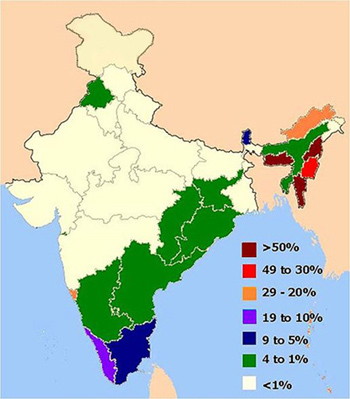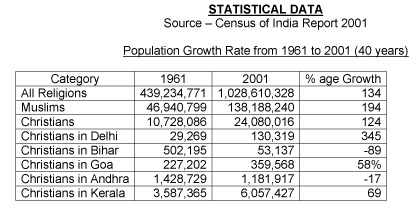India's Vanishing Christians

Christian population in different states
Nine out of ten Christians in Bihar have disappeared! In Andhra Pradesh the population of Christians has decreased. The Population Growth Rate (PGR) of Christians in Goa and Kerala is a fraction of the national average. But Delhi has seen a phenomenal growth in the number of Christians. Don’t believe me, but believe the statistics of the Census of India. A study of the figures for 1961 and 2001 (the latest available) is startling. Are they facts? Yes and no, for statistics are easily manipulatable. I do not wish to be a manipulator, so I will present both facts and figures.
The figures in the attached annexure are taken from the Census of India report of 2001. In 1961 there were 502,195 Christians in Bihar. Forty years later, in 2001, they were down to just 53,137, a drop of 89%! What the statistics don’t say is that in the interregnum a new State of Jharkhand was formed, and the majority of erstwhile Bihar’s Christians are to be found there. The data shows that the All India PGR between 1961 and 2001 was 134%. In contrast the Muslim PGR was much higher at 194%, while the Christians’ was lower at 124%. IN Delhi the Christian PGR was 345%, obviously because of immigration. Andhra Pradesh is the only State where the Christian population has actually dwindled from 1,428,729 in 1961 to 1,181,917 in 2001, a negative growth of 17%. And Telengana is still a part of Andhra. What does this indicate? Andhra has been in the forefront of the Dalit Christian movement. Is this indicative that the denial of equal rights to Dalit Christians has resulted in large-scale apostasy in Andhra? So much for our evangelisation.
Kerala and Goa are the two States that had a well-entrenched Christian presence. Their statistics merit attention. As against the national PGR of 134, and the Christian PGR of 124, in Goa the Christian PGR is lowest at 58%, and Kerala is not much better at 69%. Before we set the alarm bells ringing, we need to look at some other demographic realities.
Both Kerala and Goa have a high exodus of emigrants to other countries and States. Equally, they have a large influx of immigrant labour, as Keralites and Goans find manual labour below their dignity. Family planning is also more evident in both these States. In 2001 the Proportion of Age (0 – 6 years) had a national average of 15.9%. The average for Muslims was again higher at 18.7%, while that of Christians was lower at 13.5%. Goan Christians had the lowest proportion at 9.6%, while Kerala’s was 11.2%. Literacy has been a contributory factor. In 2001 the national literacy rate was 64.8%, while for women it was 53.7%. Among Christian Goans this was much higher at 83.8% and 78.8% respectively. Kerala Christians fared even better at 94.8% and 93.5% respectively.
One’s nature of work is also related to population growth. Those who till the land believe that for every mouth to feed there are two hands to work. They consider children an asset, not a liability. But the nature of Christian workers in Goa and Kerala again is different from the national norm. Among the categories of workers in 2001, the national average for cultivators and agricultural labourers was 58.2%. In contrast, for Goan Christians this was just 11.4%, and for Kerala Christians it was 24%. Small wonder then that all these factors have contributed to the vanishing Christians of Goa and Kerala (though Andhra is a sociological, not a demographic problem).
It is in this context that we need to address recent developments like the “Welfare of Women & Children Bill 2011” in the Kerala Assembly, and the strident reactions from Muslim and Christian religious leaders in Kerala. Why is the Bill so objectionable?
It seeks to enact harsh measures to control the population. It advocates a two-child norm; and three months’ jail or a fine of Rs 10,000/- for those who don’t follow this diktat. It further says that those organisations or individuals that campaign against family planning would also face imprisonment. This draconian measure has been likened to Sanjay Gandhi’s forced sterilisation drives during the Emergency (1975-77), and China’s one-child policy (1979).
Writing in Indian Currents (IC) Dr John Dayal says that China’s population policy has resulted in 30 million Chinese men without wives, with the attendant danger of increased violence against women and prostitution. A newspaper report says that wife-supplying agencies have erupted, arranging for women (wives) from Vietnam, with a money back guarantee of satisfaction. This is not surprising. Unabated female foeticide in India has resulted in a skewed sex ratio, with men from Haryana and Rajasthan actually paying for brides from poorer States. So the danger of excessive State control is real. However, Kerala, which incidentally has a high sex ratio, also has the highest population density of 859 persons per sq km; which Dr Dayal says is 3 times higher than the national average.
How has the Kerala church responded to this complex issue of a dense population and a draconian Bill? Long before any Bill was on the horizon the late Cardinal Vithayathil had advocated larger families; accusing parents who could afford it, of being selfish, by not producing more children. At that time I had strongly rebutted the cardinal’s convoluted logic. Now St Vincent de Paul Forane Church in Wynad district of Kerala has announced a Rs 10,000/- fixed deposit to be given to parents that produce a fifth child. The person who made the announcement, Salu Mecheril, is also the spokesperson of the Kerala Catholic Bishops’ Conference. So the announcement cannot be treated in isolation. The secular press has already splashed the news and made adverse editorial comments. The Kerala laity has also not taken this lying down. As reported in IC, Joseph Pullikkunel, Director, Indian Institute of Christian Studies, has objected, saying that “Catholic women are not just human machines producing children”.
The Kerala Bill is downright insane, even though the Christian Chief Minister of Kerala, Oommen Chandy, claims that “resentment against the draft is unwarranted”. How warranted is the reaction of the Catholic hierarchy? Rev Mathew O. Praem, writing in the same issue of IC, lets the cat out of the bag when he says that the bishops’ policy is “mainly in view of languishing vocations to priestly and religious life”. Had a layman like me said this, I would have immediately been branded anti-clerical. Coming from the horse’s mouth, need I say more? The reality is that large families in Kerala generously sent many of their offspring to novitiates and seminaries. Several foreign congregations even set up “fishing centres” in Kerala. With small families, the boom is over. They are no longer willing to contribute their mites (pun intended)!
This month the world population will cross the 7 billion mark. Here in India we are unable to define poverty. Infrastructure has collapsed, and forests have been slashed because of a burgeoning population. Voluntary family planning is essential to macro planning, and should not be opposed on purely sectarian grounds like empty novitiates and seminaries.
One must also ask the Catholic Church how effective has its propagation of Natural Family Planning (NFP) been? I taught about NFP before I got married! From the Rhythm Method we had progressed to the Sympto-Thermic Method, the Ovulation Method and the Modified Mucous Method. What happened? I throw an open challenge to the Catholic bishops of India to show us how many NFP centres are functioning in India today, and how many adherents they have. There is also mounting evidence that the Catholic Church is unable to cover the socio-economic needs of its existing members, particularly that of the Dalit Christians. So why talk of financial support to a fifth child?
The draconian Kerala bill should be thrown out, and the bishops’ fixed deposits with it. We need flexibility not fixity.




